Operations and Project Management Report: Corus and Portakabin
VerifiedAdded on 2021/02/19
|18
|5221
|44
Report
AI Summary
This report delves into operations and project management, using Corus and Portakabin as case studies. The first part focuses on Corus, a steel-making company, exploring operations management principles, including reality, success, and humility. It analyzes how these principles can address cost efficiency, quality, safety, and delivery challenges. The second part examines Portakabin, a modular innovator, focusing on the project life cycle (PLC). The report reviews and critiques the effectiveness of PLC using the waterfall model, discussing cost-saving techniques, quality assurance, and the application of various theories. Recommendations include utilizing the variance principle for cost control and the 'knowing your competition' principle for product improvement, ultimately aiming for enhanced competitiveness and customer satisfaction. The report also emphasizes lean principles and continuous improvement plans for Corus, highlighting strategies to reduce waste and improve efficiency.
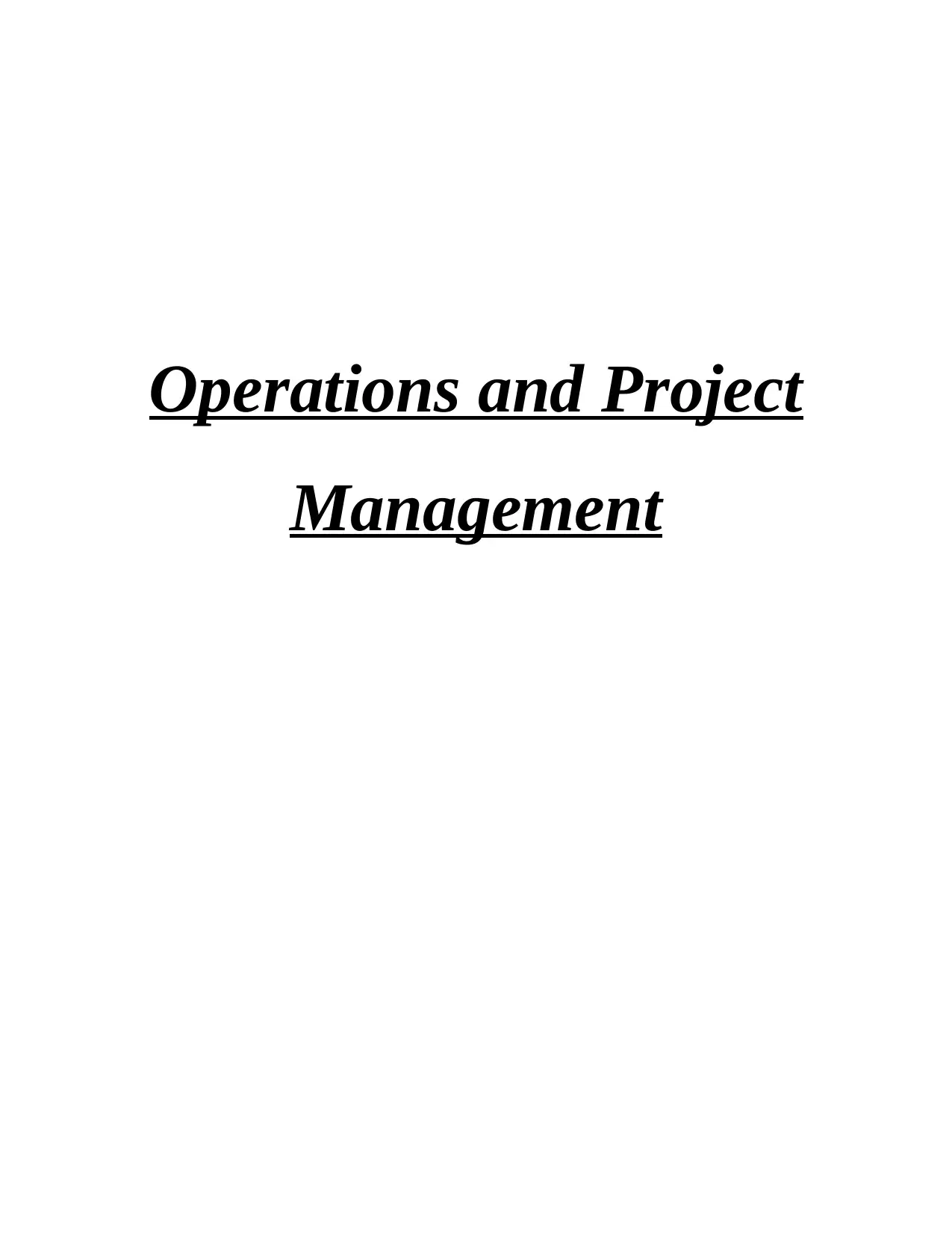
Operations and Project
Management
Management
Paraphrase This Document
Need a fresh take? Get an instant paraphrase of this document with our AI Paraphraser
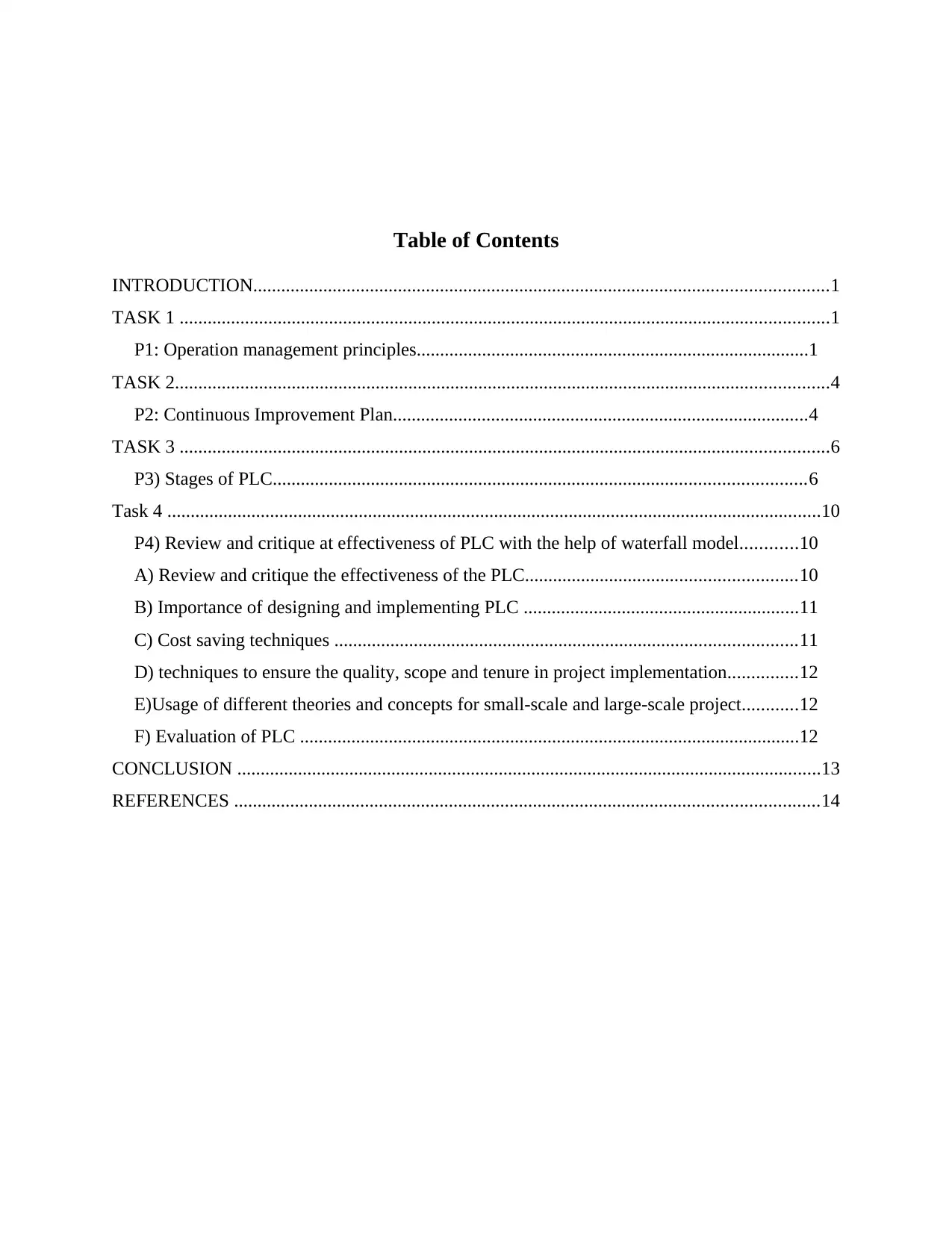
Table of Contents
INTRODUCTION...........................................................................................................................1
TASK 1 ...........................................................................................................................................1
P1: Operation management principles....................................................................................1
TASK 2............................................................................................................................................4
P2: Continuous Improvement Plan.........................................................................................4
TASK 3 ...........................................................................................................................................6
P3) Stages of PLC..................................................................................................................6
Task 4 ............................................................................................................................................10
P4) Review and critique at effectiveness of PLC with the help of waterfall model............10
A) Review and critique the effectiveness of the PLC..........................................................10
B) Importance of designing and implementing PLC ...........................................................11
C) Cost saving techniques ...................................................................................................11
D) techniques to ensure the quality, scope and tenure in project implementation...............12
E)Usage of different theories and concepts for small-scale and large-scale project............12
F) Evaluation of PLC ...........................................................................................................12
CONCLUSION .............................................................................................................................13
REFERENCES .............................................................................................................................14
INTRODUCTION...........................................................................................................................1
TASK 1 ...........................................................................................................................................1
P1: Operation management principles....................................................................................1
TASK 2............................................................................................................................................4
P2: Continuous Improvement Plan.........................................................................................4
TASK 3 ...........................................................................................................................................6
P3) Stages of PLC..................................................................................................................6
Task 4 ............................................................................................................................................10
P4) Review and critique at effectiveness of PLC with the help of waterfall model............10
A) Review and critique the effectiveness of the PLC..........................................................10
B) Importance of designing and implementing PLC ...........................................................11
C) Cost saving techniques ...................................................................................................11
D) techniques to ensure the quality, scope and tenure in project implementation...............12
E)Usage of different theories and concepts for small-scale and large-scale project............12
F) Evaluation of PLC ...........................................................................................................12
CONCLUSION .............................................................................................................................13
REFERENCES .............................................................................................................................14

⊘ This is a preview!⊘
Do you want full access?
Subscribe today to unlock all pages.

Trusted by 1+ million students worldwide
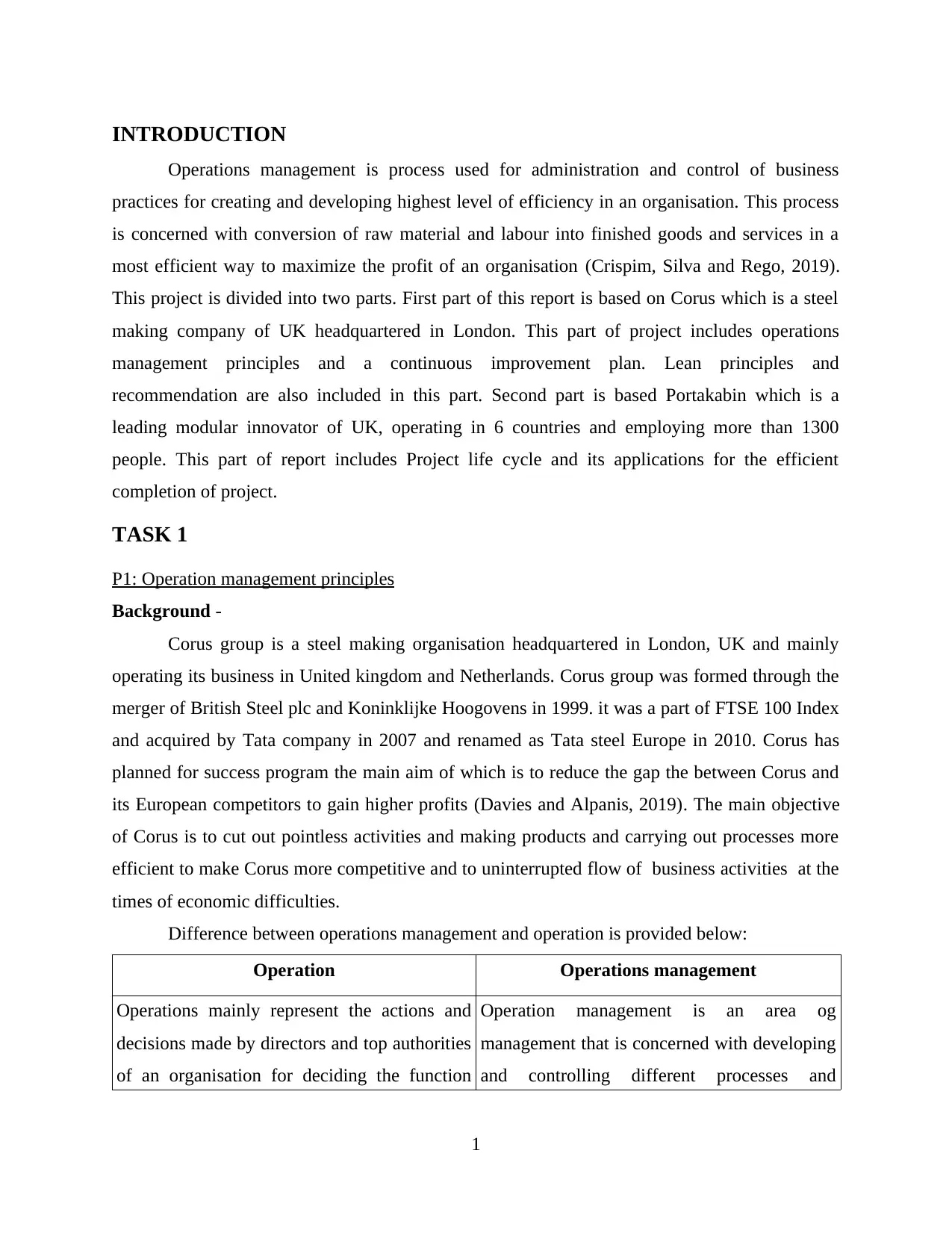
INTRODUCTION
Operations management is process used for administration and control of business
practices for creating and developing highest level of efficiency in an organisation. This process
is concerned with conversion of raw material and labour into finished goods and services in a
most efficient way to maximize the profit of an organisation (Crispim, Silva and Rego, 2019).
This project is divided into two parts. First part of this report is based on Corus which is a steel
making company of UK headquartered in London. This part of project includes operations
management principles and a continuous improvement plan. Lean principles and
recommendation are also included in this part. Second part is based Portakabin which is a
leading modular innovator of UK, operating in 6 countries and employing more than 1300
people. This part of report includes Project life cycle and its applications for the efficient
completion of project.
TASK 1
P1: Operation management principles
Background -
Corus group is a steel making organisation headquartered in London, UK and mainly
operating its business in United kingdom and Netherlands. Corus group was formed through the
merger of British Steel plc and Koninklijke Hoogovens in 1999. it was a part of FTSE 100 Index
and acquired by Tata company in 2007 and renamed as Tata steel Europe in 2010. Corus has
planned for success program the main aim of which is to reduce the gap the between Corus and
its European competitors to gain higher profits (Davies and Alpanis, 2019). The main objective
of Corus is to cut out pointless activities and making products and carrying out processes more
efficient to make Corus more competitive and to uninterrupted flow of business activities at the
times of economic difficulties.
Difference between operations management and operation is provided below:
Operation Operations management
Operations mainly represent the actions and
decisions made by directors and top authorities
of an organisation for deciding the function
Operation management is an area og
management that is concerned with developing
and controlling different processes and
1
Operations management is process used for administration and control of business
practices for creating and developing highest level of efficiency in an organisation. This process
is concerned with conversion of raw material and labour into finished goods and services in a
most efficient way to maximize the profit of an organisation (Crispim, Silva and Rego, 2019).
This project is divided into two parts. First part of this report is based on Corus which is a steel
making company of UK headquartered in London. This part of project includes operations
management principles and a continuous improvement plan. Lean principles and
recommendation are also included in this part. Second part is based Portakabin which is a
leading modular innovator of UK, operating in 6 countries and employing more than 1300
people. This part of report includes Project life cycle and its applications for the efficient
completion of project.
TASK 1
P1: Operation management principles
Background -
Corus group is a steel making organisation headquartered in London, UK and mainly
operating its business in United kingdom and Netherlands. Corus group was formed through the
merger of British Steel plc and Koninklijke Hoogovens in 1999. it was a part of FTSE 100 Index
and acquired by Tata company in 2007 and renamed as Tata steel Europe in 2010. Corus has
planned for success program the main aim of which is to reduce the gap the between Corus and
its European competitors to gain higher profits (Davies and Alpanis, 2019). The main objective
of Corus is to cut out pointless activities and making products and carrying out processes more
efficient to make Corus more competitive and to uninterrupted flow of business activities at the
times of economic difficulties.
Difference between operations management and operation is provided below:
Operation Operations management
Operations mainly represent the actions and
decisions made by directors and top authorities
of an organisation for deciding the function
Operation management is an area og
management that is concerned with developing
and controlling different processes and
1
Paraphrase This Document
Need a fresh take? Get an instant paraphrase of this document with our AI Paraphraser
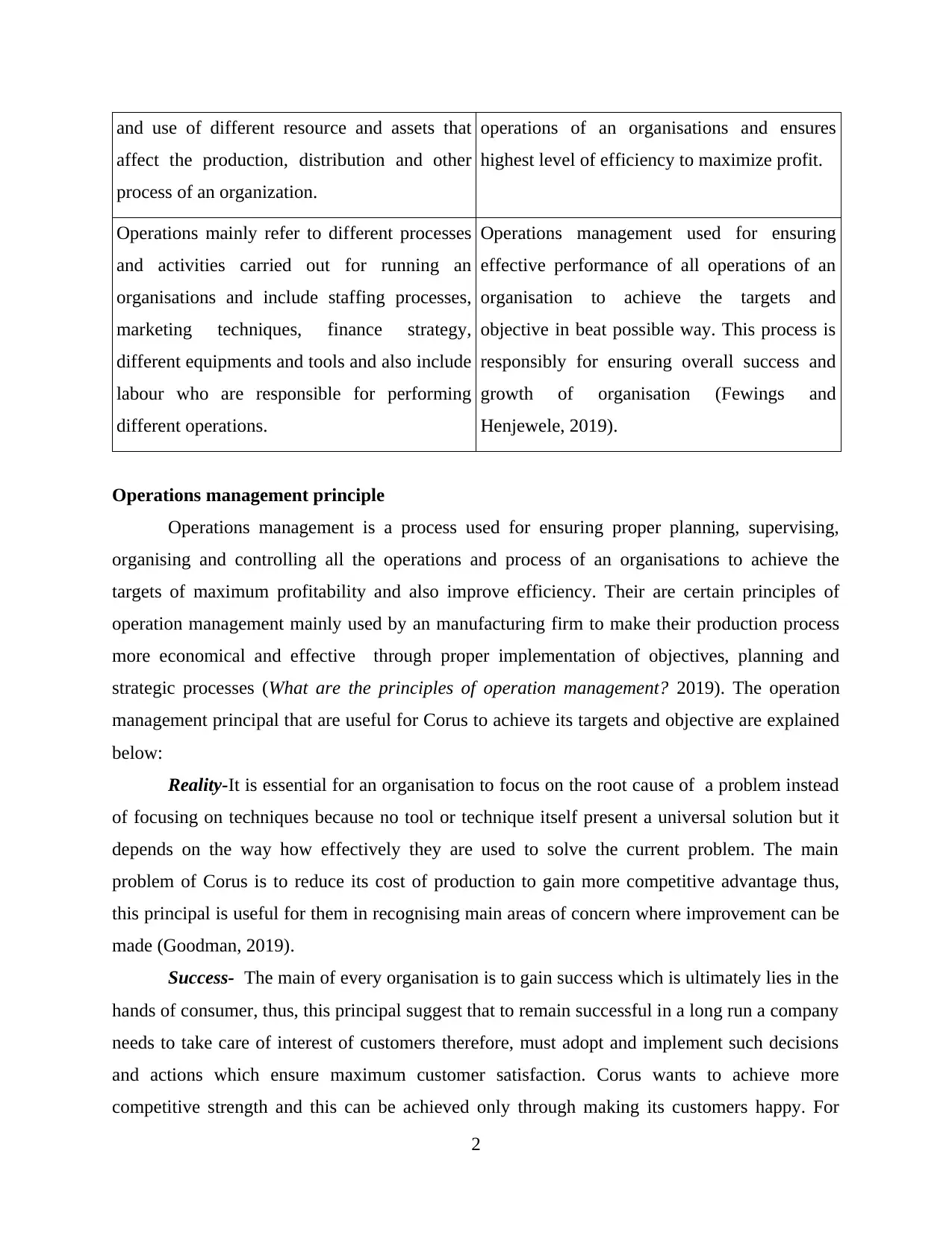
and use of different resource and assets that
affect the production, distribution and other
process of an organization.
operations of an organisations and ensures
highest level of efficiency to maximize profit.
Operations mainly refer to different processes
and activities carried out for running an
organisations and include staffing processes,
marketing techniques, finance strategy,
different equipments and tools and also include
labour who are responsible for performing
different operations.
Operations management used for ensuring
effective performance of all operations of an
organisation to achieve the targets and
objective in beat possible way. This process is
responsibly for ensuring overall success and
growth of organisation (Fewings and
Henjewele, 2019).
Operations management principle
Operations management is a process used for ensuring proper planning, supervising,
organising and controlling all the operations and process of an organisations to achieve the
targets of maximum profitability and also improve efficiency. Their are certain principles of
operation management mainly used by an manufacturing firm to make their production process
more economical and effective through proper implementation of objectives, planning and
strategic processes (What are the principles of operation management? 2019). The operation
management principal that are useful for Corus to achieve its targets and objective are explained
below:
Reality-It is essential for an organisation to focus on the root cause of a problem instead
of focusing on techniques because no tool or technique itself present a universal solution but it
depends on the way how effectively they are used to solve the current problem. The main
problem of Corus is to reduce its cost of production to gain more competitive advantage thus,
this principal is useful for them in recognising main areas of concern where improvement can be
made (Goodman, 2019).
Success- The main of every organisation is to gain success which is ultimately lies in the
hands of consumer, thus, this principal suggest that to remain successful in a long run a company
needs to take care of interest of customers therefore, must adopt and implement such decisions
and actions which ensure maximum customer satisfaction. Corus wants to achieve more
competitive strength and this can be achieved only through making its customers happy. For
2
affect the production, distribution and other
process of an organization.
operations of an organisations and ensures
highest level of efficiency to maximize profit.
Operations mainly refer to different processes
and activities carried out for running an
organisations and include staffing processes,
marketing techniques, finance strategy,
different equipments and tools and also include
labour who are responsible for performing
different operations.
Operations management used for ensuring
effective performance of all operations of an
organisation to achieve the targets and
objective in beat possible way. This process is
responsibly for ensuring overall success and
growth of organisation (Fewings and
Henjewele, 2019).
Operations management principle
Operations management is a process used for ensuring proper planning, supervising,
organising and controlling all the operations and process of an organisations to achieve the
targets of maximum profitability and also improve efficiency. Their are certain principles of
operation management mainly used by an manufacturing firm to make their production process
more economical and effective through proper implementation of objectives, planning and
strategic processes (What are the principles of operation management? 2019). The operation
management principal that are useful for Corus to achieve its targets and objective are explained
below:
Reality-It is essential for an organisation to focus on the root cause of a problem instead
of focusing on techniques because no tool or technique itself present a universal solution but it
depends on the way how effectively they are used to solve the current problem. The main
problem of Corus is to reduce its cost of production to gain more competitive advantage thus,
this principal is useful for them in recognising main areas of concern where improvement can be
made (Goodman, 2019).
Success- The main of every organisation is to gain success which is ultimately lies in the
hands of consumer, thus, this principal suggest that to remain successful in a long run a company
needs to take care of interest of customers therefore, must adopt and implement such decisions
and actions which ensure maximum customer satisfaction. Corus wants to achieve more
competitive strength and this can be achieved only through making its customers happy. For
2
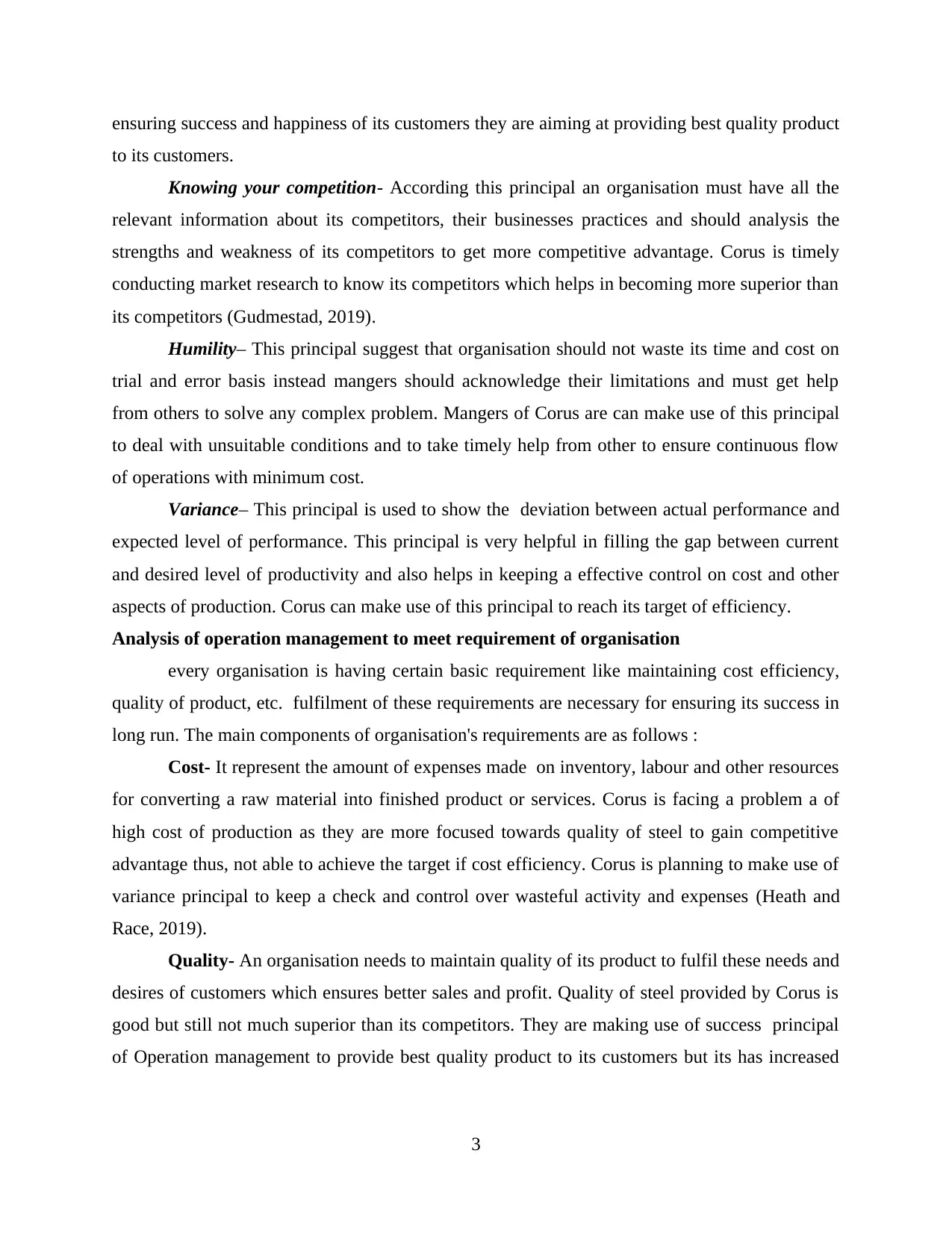
ensuring success and happiness of its customers they are aiming at providing best quality product
to its customers.
Knowing your competition- According this principal an organisation must have all the
relevant information about its competitors, their businesses practices and should analysis the
strengths and weakness of its competitors to get more competitive advantage. Corus is timely
conducting market research to know its competitors which helps in becoming more superior than
its competitors (Gudmestad, 2019).
Humility– This principal suggest that organisation should not waste its time and cost on
trial and error basis instead mangers should acknowledge their limitations and must get help
from others to solve any complex problem. Mangers of Corus are can make use of this principal
to deal with unsuitable conditions and to take timely help from other to ensure continuous flow
of operations with minimum cost.
Variance– This principal is used to show the deviation between actual performance and
expected level of performance. This principal is very helpful in filling the gap between current
and desired level of productivity and also helps in keeping a effective control on cost and other
aspects of production. Corus can make use of this principal to reach its target of efficiency.
Analysis of operation management to meet requirement of organisation
every organisation is having certain basic requirement like maintaining cost efficiency,
quality of product, etc. fulfilment of these requirements are necessary for ensuring its success in
long run. The main components of organisation's requirements are as follows :
Cost- It represent the amount of expenses made on inventory, labour and other resources
for converting a raw material into finished product or services. Corus is facing a problem a of
high cost of production as they are more focused towards quality of steel to gain competitive
advantage thus, not able to achieve the target if cost efficiency. Corus is planning to make use of
variance principal to keep a check and control over wasteful activity and expenses (Heath and
Race, 2019).
Quality- An organisation needs to maintain quality of its product to fulfil these needs and
desires of customers which ensures better sales and profit. Quality of steel provided by Corus is
good but still not much superior than its competitors. They are making use of success principal
of Operation management to provide best quality product to its customers but its has increased
3
to its customers.
Knowing your competition- According this principal an organisation must have all the
relevant information about its competitors, their businesses practices and should analysis the
strengths and weakness of its competitors to get more competitive advantage. Corus is timely
conducting market research to know its competitors which helps in becoming more superior than
its competitors (Gudmestad, 2019).
Humility– This principal suggest that organisation should not waste its time and cost on
trial and error basis instead mangers should acknowledge their limitations and must get help
from others to solve any complex problem. Mangers of Corus are can make use of this principal
to deal with unsuitable conditions and to take timely help from other to ensure continuous flow
of operations with minimum cost.
Variance– This principal is used to show the deviation between actual performance and
expected level of performance. This principal is very helpful in filling the gap between current
and desired level of productivity and also helps in keeping a effective control on cost and other
aspects of production. Corus can make use of this principal to reach its target of efficiency.
Analysis of operation management to meet requirement of organisation
every organisation is having certain basic requirement like maintaining cost efficiency,
quality of product, etc. fulfilment of these requirements are necessary for ensuring its success in
long run. The main components of organisation's requirements are as follows :
Cost- It represent the amount of expenses made on inventory, labour and other resources
for converting a raw material into finished product or services. Corus is facing a problem a of
high cost of production as they are more focused towards quality of steel to gain competitive
advantage thus, not able to achieve the target if cost efficiency. Corus is planning to make use of
variance principal to keep a check and control over wasteful activity and expenses (Heath and
Race, 2019).
Quality- An organisation needs to maintain quality of its product to fulfil these needs and
desires of customers which ensures better sales and profit. Quality of steel provided by Corus is
good but still not much superior than its competitors. They are making use of success principal
of Operation management to provide best quality product to its customers but its has increased
3
⊘ This is a preview!⊘
Do you want full access?
Subscribe today to unlock all pages.

Trusted by 1+ million students worldwide
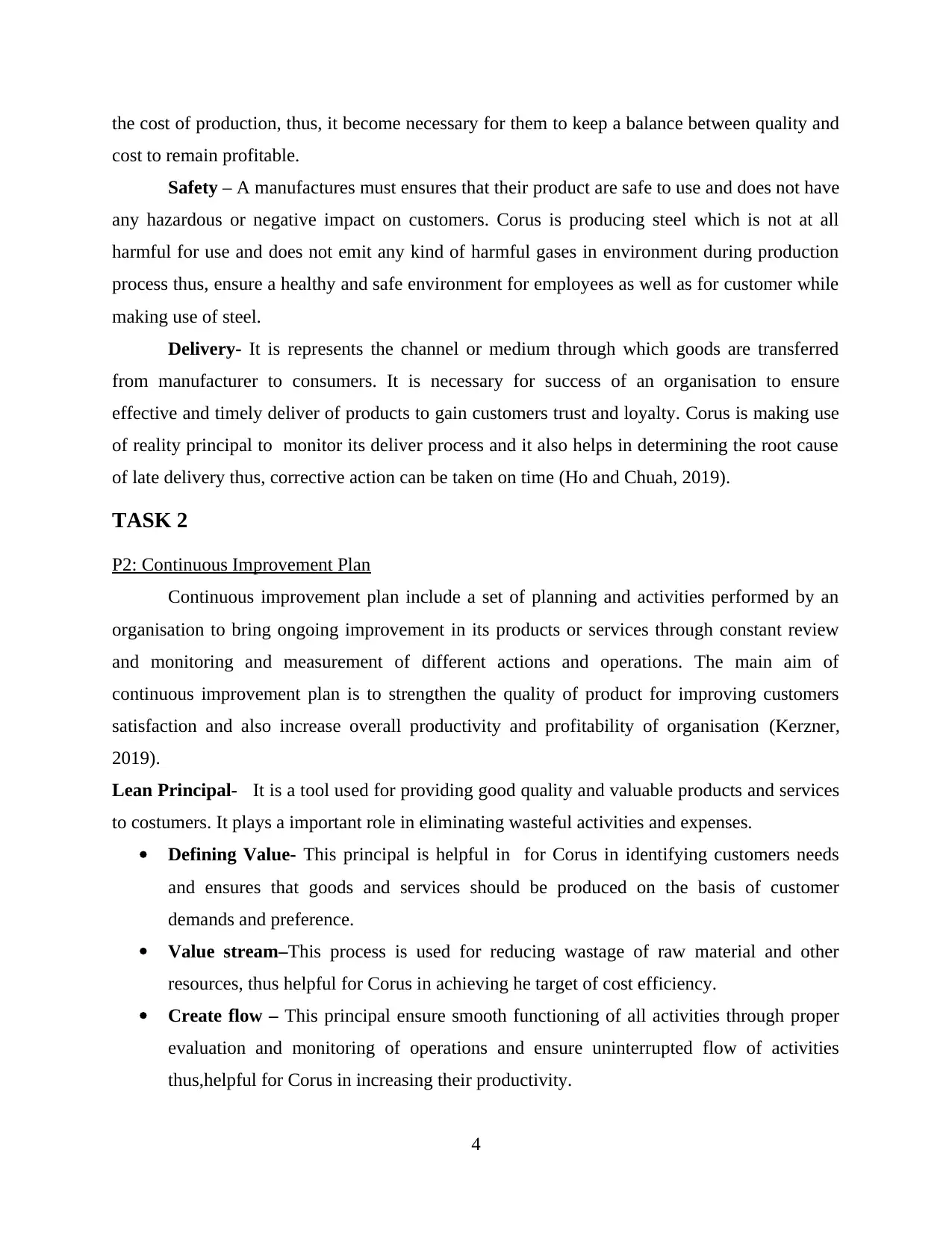
the cost of production, thus, it become necessary for them to keep a balance between quality and
cost to remain profitable.
Safety – A manufactures must ensures that their product are safe to use and does not have
any hazardous or negative impact on customers. Corus is producing steel which is not at all
harmful for use and does not emit any kind of harmful gases in environment during production
process thus, ensure a healthy and safe environment for employees as well as for customer while
making use of steel.
Delivery- It is represents the channel or medium through which goods are transferred
from manufacturer to consumers. It is necessary for success of an organisation to ensure
effective and timely deliver of products to gain customers trust and loyalty. Corus is making use
of reality principal to monitor its deliver process and it also helps in determining the root cause
of late delivery thus, corrective action can be taken on time (Ho and Chuah, 2019).
TASK 2
P2: Continuous Improvement Plan
Continuous improvement plan include a set of planning and activities performed by an
organisation to bring ongoing improvement in its products or services through constant review
and monitoring and measurement of different actions and operations. The main aim of
continuous improvement plan is to strengthen the quality of product for improving customers
satisfaction and also increase overall productivity and profitability of organisation (Kerzner,
2019).
Lean Principal- It is a tool used for providing good quality and valuable products and services
to costumers. It plays a important role in eliminating wasteful activities and expenses.
Defining Value- This principal is helpful in for Corus in identifying customers needs
and ensures that goods and services should be produced on the basis of customer
demands and preference.
Value stream–This process is used for reducing wastage of raw material and other
resources, thus helpful for Corus in achieving he target of cost efficiency.
Create flow – This principal ensure smooth functioning of all activities through proper
evaluation and monitoring of operations and ensure uninterrupted flow of activities
thus,helpful for Corus in increasing their productivity.
4
cost to remain profitable.
Safety – A manufactures must ensures that their product are safe to use and does not have
any hazardous or negative impact on customers. Corus is producing steel which is not at all
harmful for use and does not emit any kind of harmful gases in environment during production
process thus, ensure a healthy and safe environment for employees as well as for customer while
making use of steel.
Delivery- It is represents the channel or medium through which goods are transferred
from manufacturer to consumers. It is necessary for success of an organisation to ensure
effective and timely deliver of products to gain customers trust and loyalty. Corus is making use
of reality principal to monitor its deliver process and it also helps in determining the root cause
of late delivery thus, corrective action can be taken on time (Ho and Chuah, 2019).
TASK 2
P2: Continuous Improvement Plan
Continuous improvement plan include a set of planning and activities performed by an
organisation to bring ongoing improvement in its products or services through constant review
and monitoring and measurement of different actions and operations. The main aim of
continuous improvement plan is to strengthen the quality of product for improving customers
satisfaction and also increase overall productivity and profitability of organisation (Kerzner,
2019).
Lean Principal- It is a tool used for providing good quality and valuable products and services
to costumers. It plays a important role in eliminating wasteful activities and expenses.
Defining Value- This principal is helpful in for Corus in identifying customers needs
and ensures that goods and services should be produced on the basis of customer
demands and preference.
Value stream–This process is used for reducing wastage of raw material and other
resources, thus helpful for Corus in achieving he target of cost efficiency.
Create flow – This principal ensure smooth functioning of all activities through proper
evaluation and monitoring of operations and ensure uninterrupted flow of activities
thus,helpful for Corus in increasing their productivity.
4
Paraphrase This Document
Need a fresh take? Get an instant paraphrase of this document with our AI Paraphraser
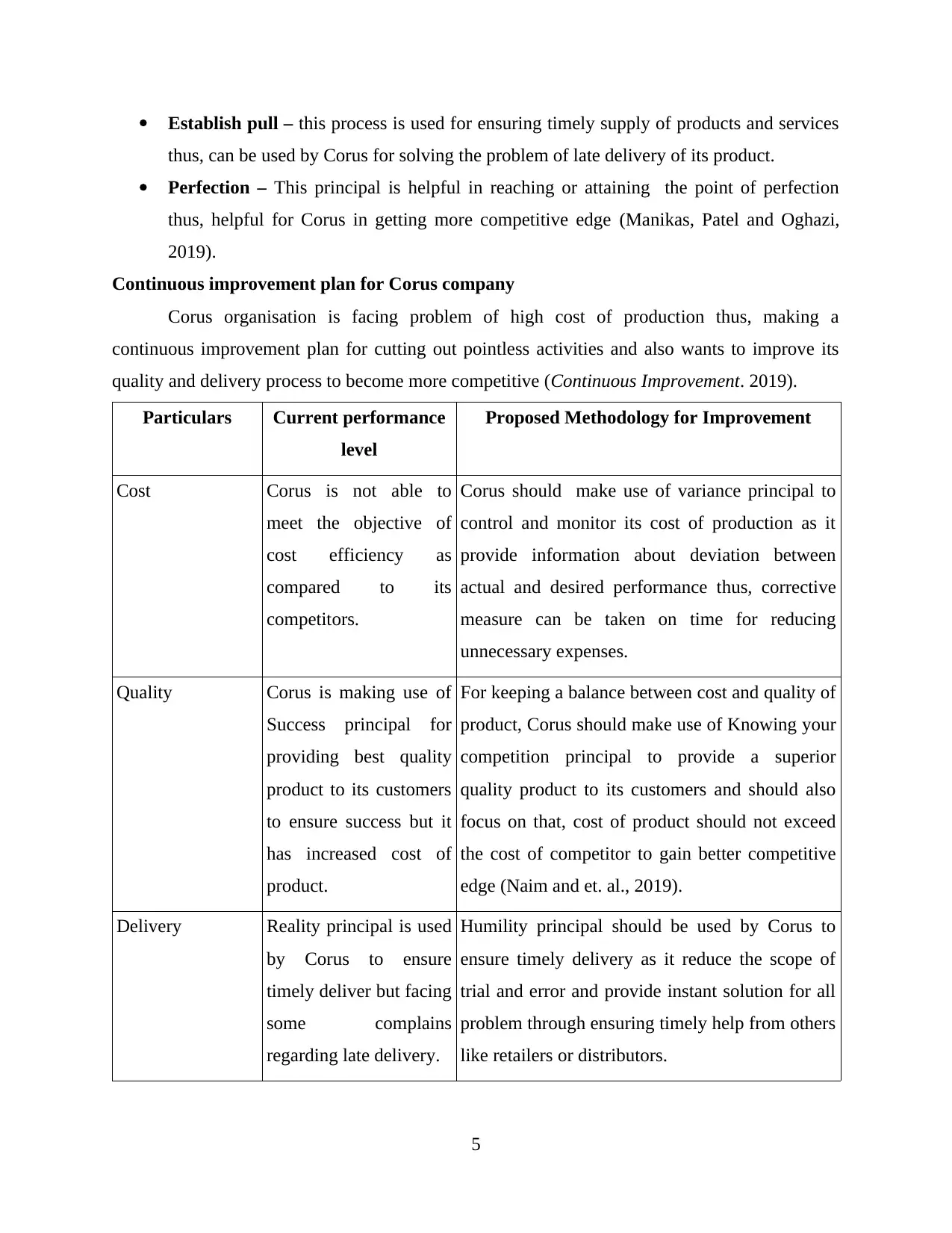
Establish pull – this process is used for ensuring timely supply of products and services
thus, can be used by Corus for solving the problem of late delivery of its product.
Perfection – This principal is helpful in reaching or attaining the point of perfection
thus, helpful for Corus in getting more competitive edge (Manikas, Patel and Oghazi,
2019).
Continuous improvement plan for Corus company
Corus organisation is facing problem of high cost of production thus, making a
continuous improvement plan for cutting out pointless activities and also wants to improve its
quality and delivery process to become more competitive (Continuous Improvement. 2019).
Particulars Current performance
level
Proposed Methodology for Improvement
Cost Corus is not able to
meet the objective of
cost efficiency as
compared to its
competitors.
Corus should make use of variance principal to
control and monitor its cost of production as it
provide information about deviation between
actual and desired performance thus, corrective
measure can be taken on time for reducing
unnecessary expenses.
Quality Corus is making use of
Success principal for
providing best quality
product to its customers
to ensure success but it
has increased cost of
product.
For keeping a balance between cost and quality of
product, Corus should make use of Knowing your
competition principal to provide a superior
quality product to its customers and should also
focus on that, cost of product should not exceed
the cost of competitor to gain better competitive
edge (Naim and et. al., 2019).
Delivery Reality principal is used
by Corus to ensure
timely deliver but facing
some complains
regarding late delivery.
Humility principal should be used by Corus to
ensure timely delivery as it reduce the scope of
trial and error and provide instant solution for all
problem through ensuring timely help from others
like retailers or distributors.
5
thus, can be used by Corus for solving the problem of late delivery of its product.
Perfection – This principal is helpful in reaching or attaining the point of perfection
thus, helpful for Corus in getting more competitive edge (Manikas, Patel and Oghazi,
2019).
Continuous improvement plan for Corus company
Corus organisation is facing problem of high cost of production thus, making a
continuous improvement plan for cutting out pointless activities and also wants to improve its
quality and delivery process to become more competitive (Continuous Improvement. 2019).
Particulars Current performance
level
Proposed Methodology for Improvement
Cost Corus is not able to
meet the objective of
cost efficiency as
compared to its
competitors.
Corus should make use of variance principal to
control and monitor its cost of production as it
provide information about deviation between
actual and desired performance thus, corrective
measure can be taken on time for reducing
unnecessary expenses.
Quality Corus is making use of
Success principal for
providing best quality
product to its customers
to ensure success but it
has increased cost of
product.
For keeping a balance between cost and quality of
product, Corus should make use of Knowing your
competition principal to provide a superior
quality product to its customers and should also
focus on that, cost of product should not exceed
the cost of competitor to gain better competitive
edge (Naim and et. al., 2019).
Delivery Reality principal is used
by Corus to ensure
timely deliver but facing
some complains
regarding late delivery.
Humility principal should be used by Corus to
ensure timely delivery as it reduce the scope of
trial and error and provide instant solution for all
problem through ensuring timely help from others
like retailers or distributors.
5
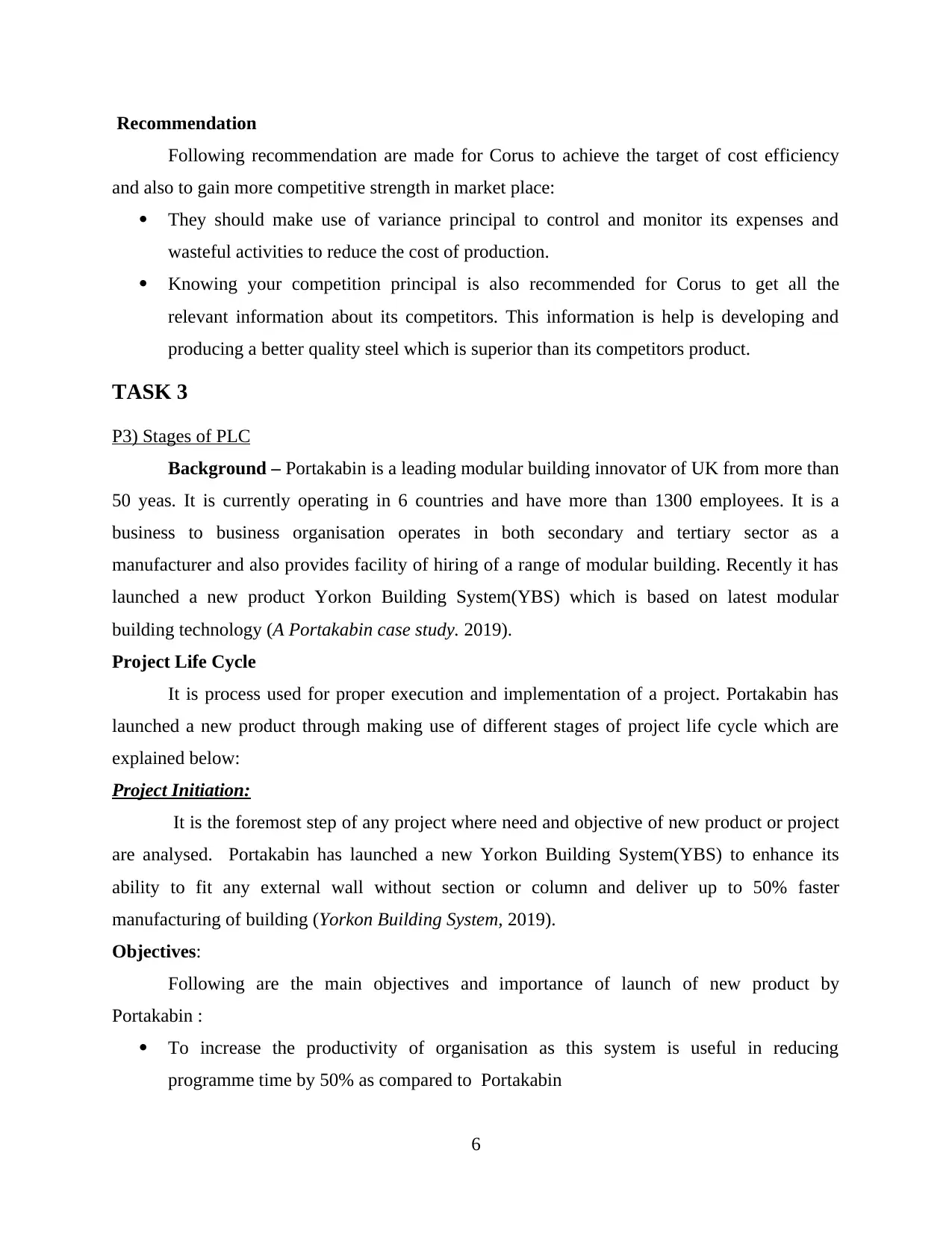
Recommendation
Following recommendation are made for Corus to achieve the target of cost efficiency
and also to gain more competitive strength in market place:
They should make use of variance principal to control and monitor its expenses and
wasteful activities to reduce the cost of production.
Knowing your competition principal is also recommended for Corus to get all the
relevant information about its competitors. This information is help is developing and
producing a better quality steel which is superior than its competitors product.
TASK 3
P3) Stages of PLC
Background – Portakabin is a leading modular building innovator of UK from more than
50 yeas. It is currently operating in 6 countries and have more than 1300 employees. It is a
business to business organisation operates in both secondary and tertiary sector as a
manufacturer and also provides facility of hiring of a range of modular building. Recently it has
launched a new product Yorkon Building System(YBS) which is based on latest modular
building technology (A Portakabin case study. 2019).
Project Life Cycle
It is process used for proper execution and implementation of a project. Portakabin has
launched a new product through making use of different stages of project life cycle which are
explained below:
Project Initiation:
It is the foremost step of any project where need and objective of new product or project
are analysed. Portakabin has launched a new Yorkon Building System(YBS) to enhance its
ability to fit any external wall without section or column and deliver up to 50% faster
manufacturing of building (Yorkon Building System, 2019).
Objectives:
Following are the main objectives and importance of launch of new product by
Portakabin :
To increase the productivity of organisation as this system is useful in reducing
programme time by 50% as compared to Portakabin
6
Following recommendation are made for Corus to achieve the target of cost efficiency
and also to gain more competitive strength in market place:
They should make use of variance principal to control and monitor its expenses and
wasteful activities to reduce the cost of production.
Knowing your competition principal is also recommended for Corus to get all the
relevant information about its competitors. This information is help is developing and
producing a better quality steel which is superior than its competitors product.
TASK 3
P3) Stages of PLC
Background – Portakabin is a leading modular building innovator of UK from more than
50 yeas. It is currently operating in 6 countries and have more than 1300 employees. It is a
business to business organisation operates in both secondary and tertiary sector as a
manufacturer and also provides facility of hiring of a range of modular building. Recently it has
launched a new product Yorkon Building System(YBS) which is based on latest modular
building technology (A Portakabin case study. 2019).
Project Life Cycle
It is process used for proper execution and implementation of a project. Portakabin has
launched a new product through making use of different stages of project life cycle which are
explained below:
Project Initiation:
It is the foremost step of any project where need and objective of new product or project
are analysed. Portakabin has launched a new Yorkon Building System(YBS) to enhance its
ability to fit any external wall without section or column and deliver up to 50% faster
manufacturing of building (Yorkon Building System, 2019).
Objectives:
Following are the main objectives and importance of launch of new product by
Portakabin :
To increase the productivity of organisation as this system is useful in reducing
programme time by 50% as compared to Portakabin
6
⊘ This is a preview!⊘
Do you want full access?
Subscribe today to unlock all pages.

Trusted by 1+ million students worldwide

To increase the profitability through reducing material wastage up to 90% as compared
with traditional method of constructions
To reduce the building carbon footprint through reducing number of vehicle movements
on construction site .
To gain more competitive strength to remain ahead of its competitors through making use
of latest technology.
Strategies
Proper strategies and plans were made by Portakabin for launch of its new product.
Gantt char and work break down structure were used for allocation of work into team members.
TQM was used for ensuring proper execution of project through maintaining desired quality
(Park and et. al., 2019).
Project planning
This process includes is complete structure and frame of an project. A detail description
of all the stages and activities are provided in project planning to complete project on time
(Portakabin . 2019). Following planing was made Portakabin for launch of its product:
Cost The estimated total cost of of new project was £ 1800000 which
includes technology cost, manufacturing cost of system and all other
expenses.
Communication Portakabin has made use of effective communication Chanel where
use of both written and oral mode is made for ensuring better flow
of ides and knowledge. This helped Portakabin in reducing conflicts
and confusion among team members and employees.
Quality Portakabin had developed a new technique for faster construction
thus, it become necessary to properly check its quality and
effectiveness before launching it in market. For that purpose, use of
TQM technique was made.
Scope The scope of this new system is wide as it had provided a better and
much faster way of construction thus, it has helped in increasing
productivity of Portakabin (Rendon and Snider, 2019).
Target market Portakabin is a business to business organisation thus, it target
7
with traditional method of constructions
To reduce the building carbon footprint through reducing number of vehicle movements
on construction site .
To gain more competitive strength to remain ahead of its competitors through making use
of latest technology.
Strategies
Proper strategies and plans were made by Portakabin for launch of its new product.
Gantt char and work break down structure were used for allocation of work into team members.
TQM was used for ensuring proper execution of project through maintaining desired quality
(Park and et. al., 2019).
Project planning
This process includes is complete structure and frame of an project. A detail description
of all the stages and activities are provided in project planning to complete project on time
(Portakabin . 2019). Following planing was made Portakabin for launch of its product:
Cost The estimated total cost of of new project was £ 1800000 which
includes technology cost, manufacturing cost of system and all other
expenses.
Communication Portakabin has made use of effective communication Chanel where
use of both written and oral mode is made for ensuring better flow
of ides and knowledge. This helped Portakabin in reducing conflicts
and confusion among team members and employees.
Quality Portakabin had developed a new technique for faster construction
thus, it become necessary to properly check its quality and
effectiveness before launching it in market. For that purpose, use of
TQM technique was made.
Scope The scope of this new system is wide as it had provided a better and
much faster way of construction thus, it has helped in increasing
productivity of Portakabin (Rendon and Snider, 2019).
Target market Portakabin is a business to business organisation thus, it target
7
Paraphrase This Document
Need a fresh take? Get an instant paraphrase of this document with our AI Paraphraser
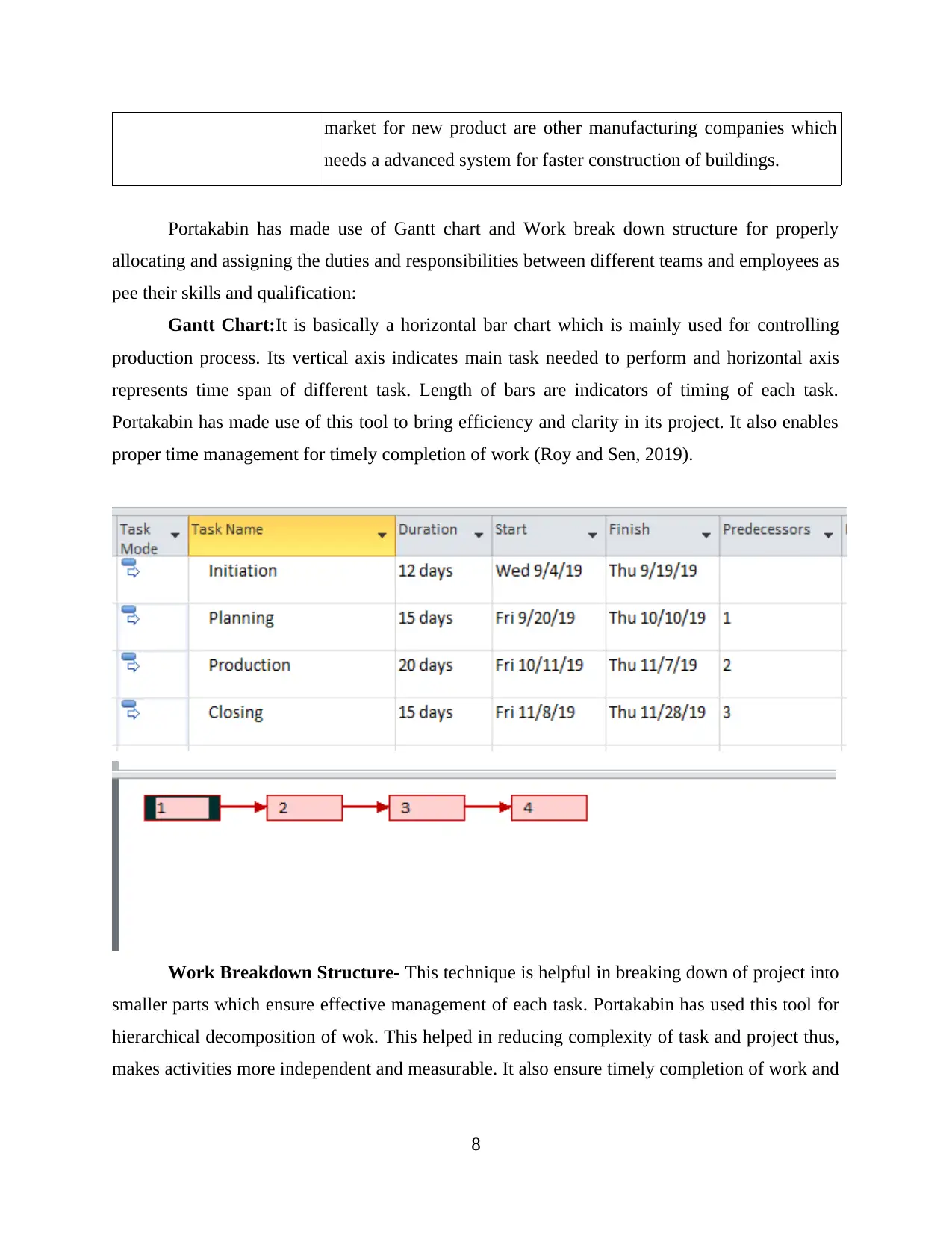
market for new product are other manufacturing companies which
needs a advanced system for faster construction of buildings.
Portakabin has made use of Gantt chart and Work break down structure for properly
allocating and assigning the duties and responsibilities between different teams and employees as
pee their skills and qualification:
Gantt Chart:It is basically a horizontal bar chart which is mainly used for controlling
production process. Its vertical axis indicates main task needed to perform and horizontal axis
represents time span of different task. Length of bars are indicators of timing of each task.
Portakabin has made use of this tool to bring efficiency and clarity in its project. It also enables
proper time management for timely completion of work (Roy and Sen, 2019).
Work Breakdown Structure- This technique is helpful in breaking down of project into
smaller parts which ensure effective management of each task. Portakabin has used this tool for
hierarchical decomposition of wok. This helped in reducing complexity of task and project thus,
makes activities more independent and measurable. It also ensure timely completion of work and
8
needs a advanced system for faster construction of buildings.
Portakabin has made use of Gantt chart and Work break down structure for properly
allocating and assigning the duties and responsibilities between different teams and employees as
pee their skills and qualification:
Gantt Chart:It is basically a horizontal bar chart which is mainly used for controlling
production process. Its vertical axis indicates main task needed to perform and horizontal axis
represents time span of different task. Length of bars are indicators of timing of each task.
Portakabin has made use of this tool to bring efficiency and clarity in its project. It also enables
proper time management for timely completion of work (Roy and Sen, 2019).
Work Breakdown Structure- This technique is helpful in breaking down of project into
smaller parts which ensure effective management of each task. Portakabin has used this tool for
hierarchical decomposition of wok. This helped in reducing complexity of task and project thus,
makes activities more independent and measurable. It also ensure timely completion of work and
8
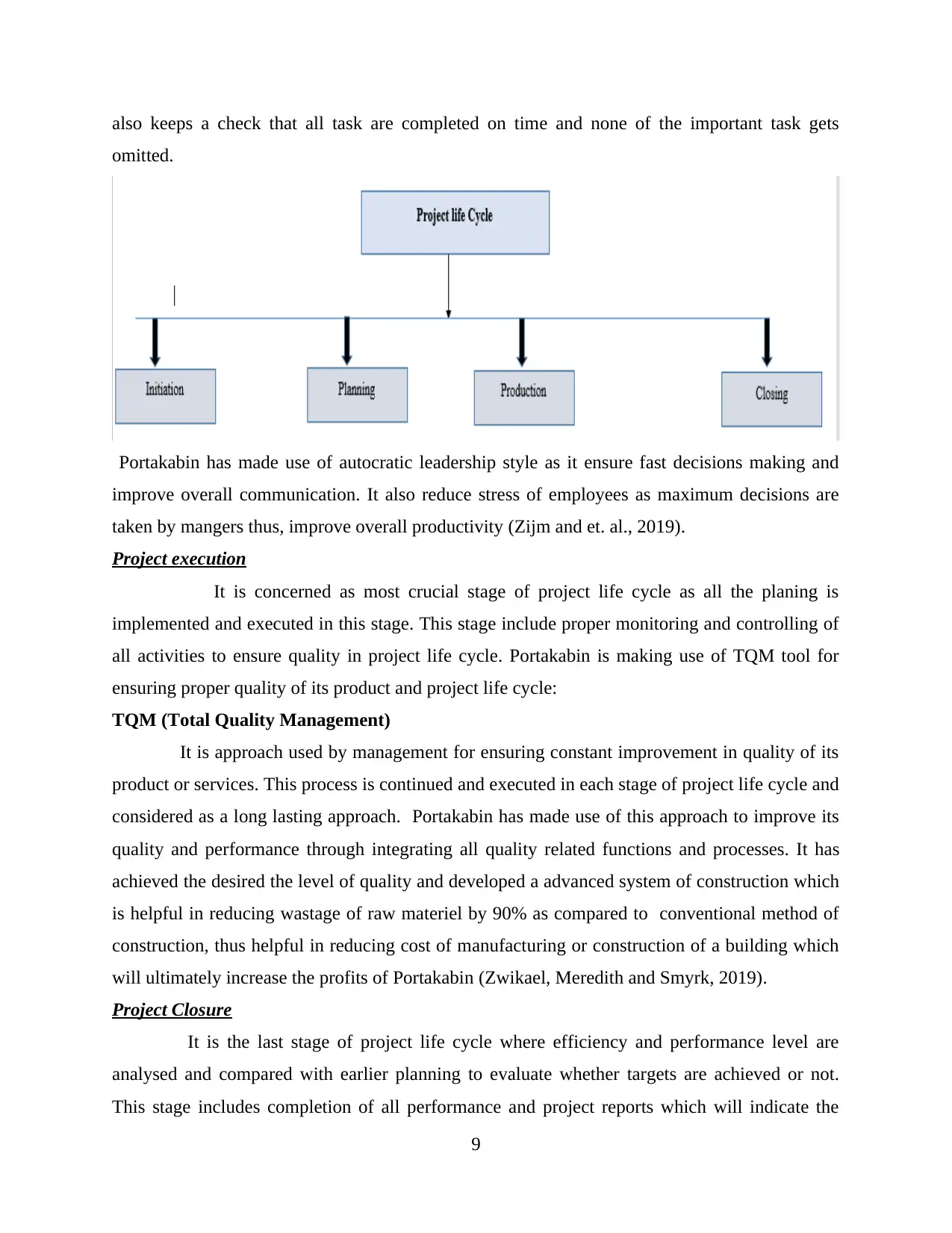
also keeps a check that all task are completed on time and none of the important task gets
omitted.
Portakabin has made use of autocratic leadership style as it ensure fast decisions making and
improve overall communication. It also reduce stress of employees as maximum decisions are
taken by mangers thus, improve overall productivity (Zijm and et. al., 2019).
Project execution
It is concerned as most crucial stage of project life cycle as all the planing is
implemented and executed in this stage. This stage include proper monitoring and controlling of
all activities to ensure quality in project life cycle. Portakabin is making use of TQM tool for
ensuring proper quality of its product and project life cycle:
TQM (Total Quality Management)
It is approach used by management for ensuring constant improvement in quality of its
product or services. This process is continued and executed in each stage of project life cycle and
considered as a long lasting approach. Portakabin has made use of this approach to improve its
quality and performance through integrating all quality related functions and processes. It has
achieved the desired the level of quality and developed a advanced system of construction which
is helpful in reducing wastage of raw materiel by 90% as compared to conventional method of
construction, thus helpful in reducing cost of manufacturing or construction of a building which
will ultimately increase the profits of Portakabin (Zwikael, Meredith and Smyrk, 2019).
Project Closure
It is the last stage of project life cycle where efficiency and performance level are
analysed and compared with earlier planning to evaluate whether targets are achieved or not.
This stage includes completion of all performance and project reports which will indicate the
9
omitted.
Portakabin has made use of autocratic leadership style as it ensure fast decisions making and
improve overall communication. It also reduce stress of employees as maximum decisions are
taken by mangers thus, improve overall productivity (Zijm and et. al., 2019).
Project execution
It is concerned as most crucial stage of project life cycle as all the planing is
implemented and executed in this stage. This stage include proper monitoring and controlling of
all activities to ensure quality in project life cycle. Portakabin is making use of TQM tool for
ensuring proper quality of its product and project life cycle:
TQM (Total Quality Management)
It is approach used by management for ensuring constant improvement in quality of its
product or services. This process is continued and executed in each stage of project life cycle and
considered as a long lasting approach. Portakabin has made use of this approach to improve its
quality and performance through integrating all quality related functions and processes. It has
achieved the desired the level of quality and developed a advanced system of construction which
is helpful in reducing wastage of raw materiel by 90% as compared to conventional method of
construction, thus helpful in reducing cost of manufacturing or construction of a building which
will ultimately increase the profits of Portakabin (Zwikael, Meredith and Smyrk, 2019).
Project Closure
It is the last stage of project life cycle where efficiency and performance level are
analysed and compared with earlier planning to evaluate whether targets are achieved or not.
This stage includes completion of all performance and project reports which will indicate the
9
⊘ This is a preview!⊘
Do you want full access?
Subscribe today to unlock all pages.

Trusted by 1+ million students worldwide
1 out of 18
Related Documents
Your All-in-One AI-Powered Toolkit for Academic Success.
+13062052269
info@desklib.com
Available 24*7 on WhatsApp / Email
![[object Object]](/_next/static/media/star-bottom.7253800d.svg)
Unlock your academic potential
Copyright © 2020–2025 A2Z Services. All Rights Reserved. Developed and managed by ZUCOL.




